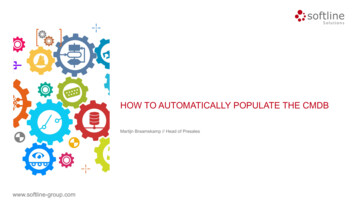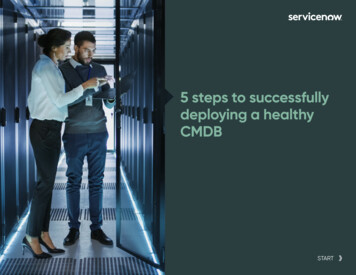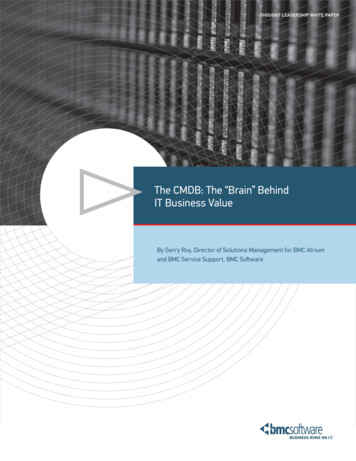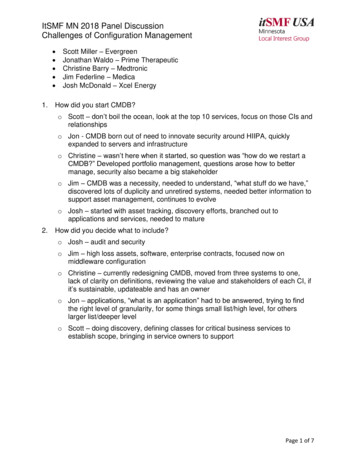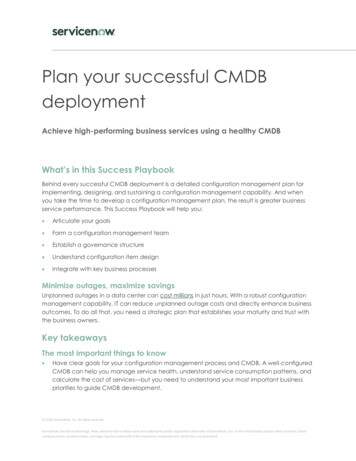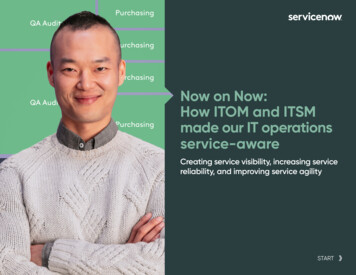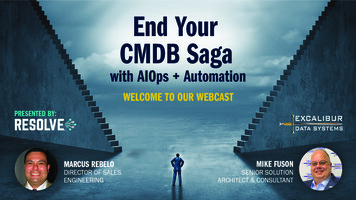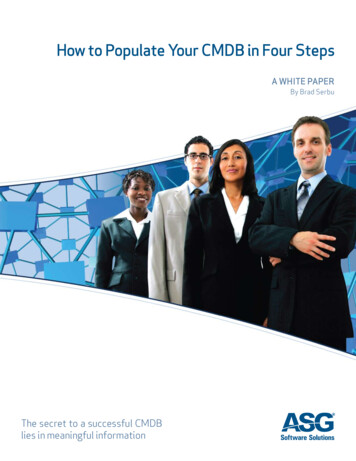
Transcription
How to Populate Your CMDB in Four StepsA WHITE PAPERBy Brad SerbuThe secret to a successful CMDBlies in meaningful information
How to Populate Your CMDB in Four StepsThe tire-kicking phase is over for configurationmanagement databases (CMDBs). Spurred by earlyadopter success stories, which often report an ROI of200 percent, 400 percent, or more,1 more than 65 percentof enterprise IT shops are currently in the process ofimplementing a CMDB solution.2Besides being billed as a must-have for IT Infrastructure Library (ITIL ) adopters, a CMDB brings an attractive assortment ofoperational benefits, including improved service levels, reduceddowntime, and fewer outages. These cost-saving advantages, alongwith the high cost of not deploying one, have incited companies tostart CMDB projects.There is, however, a flip side to this sunny scenario. A significantnumber of organizations have experienced disappointing resultsfrom their CMDBs. According to independent research from leadinganalyst firm Enterprise Management Associates (EMA), 44 percentof enterprises rated the overall success of their CMDB effort as “fair”or “poor.”3 And then there are troubling failure rates. EMA’s survey ofIT infrastructure and operations leaders at Fortune 500 companiesshows that 77 percent of respondents experienced a partial or failedCMDB implementation 18 months after purchase.4These findings have discouraged some CMDB evangelists, butunnecessarily so. Generally speaking, it’s not a CMDB’s technologythat is insufficient, but rather, how it is populated. If the appropriateinformation model is not built into the CMDB before it is populated, itwill fail—simply because it will contain massive amounts of irrelevantinformation. For CMDBs to be effective, they must be useful; theymust be able to access data that answers business questions andsolves business problems. CMDBs that are populated with discoverydata alone do not function in this way.Steps to a Successful CMDB Population1. Identify the scope of your CMDB project2. Determine the discovery data this is relevantto your projectProhibitive MisconceptionsUnderlying many CMDB disappointments are misconceptions that arelikely to misguide implementation efforts.A CMDB is a “thing.” As EMA’s Dennis Drogseth emphasizes, theCMDB is “a system in which politics, culture, organization, technology,and products all come together.”5 Organizations assuming thata CMDB is a “thing” run the risk of not investing enough in preimplementation planning, which is one of the chief reasons EMAidentifies for CMDB failures. Instead of properly planning theCMDB project, IT teams frequently become overly focused onthe technology.6 As a result, their expectations for the CMDB’sperformance typically run high. However, as Drogseth cautions, “Youcan purchase software that may be strategically useful in creating aCMDB system, but it’s not a matter of opening a box and pluggingin a new model train.”7The CMDB will solve data quality problems. Many organizationsrush to implement a CMDB because they believe that having a singlesource of record will solve the problem of poor data quality. But evenwith periodic audits for refreshing data in the CMDB, the informationis actionable only when it is 97 percent accurate, according to datamanagement experts. Because change requests are constant, thedata in the CMDB is able to maintain this accuracy level for brief timeperiods, immediately after the audits are complete. After severalexperiences with misleading data, many users decide that the CMDBis unreliable and stop using it. To avoid this outcome, implementationteams must achieve continuous data quality assurance before, during,and after CMDB implementation.The CMDB must contain every configuration item (CI). Thethought of populating the CMDB overwhelms some businessesbecause they believe they must store every piece of data in theCMDB. While autodiscovery tools take the proposition of manualpopulation off the table, they, too, can confound professionals withthe tremendous amounts of data they can capture.8 However, notevery CI is appropriate for CMDB storage; accordingly, populatingthe CMDB is not entirely an automatic, tool-driven process. ITorganizations must determine which CIs are important to monitor forthe business; these CIs belong in the CMDB and should be built intoits information model.3. Build a business-focused information modelfor the CMDB4. Extract, transform, and load data into the CMDB1
Why are CMDBs Unsuccessful?[M]any CMDB projects fail because the implementationteam is too action-oriented, overly focused on thetechnology, and devotes too little time to properly planout the effort.9A New Mindset: The CMDB as a ProcessThe CMDB should be conceived as a process or a journey.10 Justas the IT environment is organic, so is the CMDB. Embracing thismindset will keep IT teams from trying to do too much, too early,with their CMDB—a misstep that leads to overpopulating the CMDBwith configuration data that has no business significance. Burdenedby a glut of data, the CMDB cannot be used to evaluate simpleconfiguration changes, such as the feasibility of one departmentswitching from Oracle to SQL Server . Organizations that wereinitially in a hurry to populate their CMDBs find out later how timeconsuming it is to organize the precipitating glob of data to find theinformation they really need.A CMDB’s success hinges on having the right data. The best way toachieve this is to populate the CMDB gradually, following a series ofplanned steps that lead to building a business-focused informationmodel. It is this model that enables the CMDB to identify relevantdata and ensure the proper process for accessing it.2Four Steps, One Successful CMDBThe CMDB’s ability to transform data into meaningful information issecured with its proper population, which can be accomplished infour steps.1StepDefine the Project ScopeA frequent problem with CMDB projects is that they are too broadand lack short-term wins—a situation that encourages scope creepand budget overruns.11 Fortunately, this scenario can be avoidedby simply narrowing the scope of expectations attached to theCMDB. Instead of attempting to model every IT component in theenterprise, which results in a purely technical view, adopt a top-downapproach that begins with the business. Focus on a critical service, agiven domain, or a line of business. Work with the business ownersof the project to identify a specific business problem that occurs inone department or during a particular service delivery. Articulatethe questions that need answers. Then, formulate objectives forthe CMDB project that effectively address the problem. Specifyboth short- and long-term goals (e.g., six and 12 months or more,respectively).12This type of high-level whiteboard diagram, created in Step One, is extremely useful for IT and business teams because it providesthem with a map of the CMDB project that they can mutually refer to as the CMDB project evolves.
How to Populate Your CMDB in Four StepsAfter the business problem and project objectives have been identified,loosely sketch how the business owners see the IT infrastructure asit relates to their individual department/service. Maintaining thishigh-level view, identify the core CIs (such as configuration, asset, andinventory information) necessary for achieving the business-definedproject objectives. Next, draw arrows representing relationships amongcore CIs without delineating their attributes.This rough sketch defines how the CMDB will be used and whatit will manage. By identifying this information, organizationsessentially lay the groundwork for the CMDB’s information modelfrom a business view.2StepIdentify Discovery DataThe goal at this juncture is two-fold: (1) to determine the relevantdata sources that hold answers to the business problem articulatedin Step One and (2) to identify each data source’s structure, format,location, and other information needed to understand the type ofadapter needed to access and transfer discovery data into the CMDB.Start by working with the technical owners of the project to identifythe managing and monitoring products (or trusted discovery datasources) that are connected to each core CI identified in Step One.Then, identify the formats of these data sources (e.g., database, logfile, XML, CSV, WS, report).At this stage, it is not important to map how data in the raw sourcesrelates to the business view. Instead, note how each of the products,or data sources, represents and works with the data internally:3StepNext, an information model must be created in the CMDB to ensurethat only CIs and relationships that are clearly tied to Step One’sbusiness objectives are loaded into the CMDB. Begin by developinga comprehensive topology of the information needed to fulfill thebusiness objectives. Add CIs as necessary, defining CI attributes andthe relationships between and among CIs.This schema, or organizing structure, expands and further refinesthe business view sketch developed in Step One. For the modelto be usable in impact analysis, it should contain CIs that modelactual configurations, as well as related CIs that model documentedconfigurations.Rules for governing the integrity of the data should also be definedand incorporated into the information model to ensure that therelevant configuration data is accurate, consistent, and accessible.These business rules, which may include constraints that specifyconditions or relationships that must always be true or mustalways be false, help identify anomalies in source data so it can betransformed appropriately.When the CI topology and data integrity rules are completed, theCMDB will have a filter (in the form of an empty model) that canseparate the business-relevant information from other, nonessentialdata.4StepHow often is the source updated?How many times per day do the technical ownersuse the information in the product?Are there related products used inconjunction with the data source?Are there any access or security restrictions?The answers to these questions, combined with the designation ofeach data source’s format, will result in a basic understanding of theadapter types required to populate the CMDB.Build the Information ModelExtract, Transform, and Load (ETL)The goal of this phase is to access and validate raw data, transferringit to the information model in the CMDB.ExtractFirst, work with the technical staff to obtain, configure, or build anadapter to connect to the specific format of each data source. Be sureto identify any changes (such as added monitoring products, new ordifferent data formats, etc.) that have occurred since the completionof Step Two.Use the newly constructed adapters to read, copy, and move the rawdata into a transient data source (or staging area) for processing.3
TransformUse the business rules that were defined in Step Three to map theraw data to the information model. Keep in mind that one raw datasource can become the information source for several CIs or CI typesin the CMDB’s information model, as in the case of a single locationfunctioning as an attribute of multiple firewalls and routers.Next, perform the data transformation, using a processing engine toconvert the raw data from its original state into the form required tomove it from the staging area and into the CMDB. This may involvereformatting and/or cleansing the data to remove duplicates andinconsistencies.LoadFinally, connect adapters to the processing engine, transporting andloading the transformed data results into the CMDB.When Step Four is concluded, the raw configuration data will havebusiness significance because it has been filtered through theinformation model. Both IT and business owners can then use theCMDB to determine how systems are actually configured in the fieldand compare these facts to the service definitions that describe howthe systems should be configured.The Desired OutcomeThe result of a properly populated CMDB is one validated,integrated source of truth that decision makers throughoutan organization can use with confidence.The Impact of CMDB SelectionWhile following the four main steps outlined in this paper,organizations can accelerate their project’s time-to-results by ensuringtheir CMDB has the following characteristics:A metadata repository. This database model is more flexible than arelational database, allowing for adjustments (e.g., software upgrades)without completely rebuilding the core model.Federation. A federated CMDB can access data from any source,regardless of its vendor or location; with federation, no piece of data isinaccessible for population.4Autodiscovery. This capability, which replaces manual dependencymapping, ensures that only the most accurate data is loaded into theCMDB.Dependency mapping. A CMDB that can automatically drawrelationships between CIs saves substantial time and labor whenbuilding the CMDB’s information model.ASG’s metaCMDB ASG’s metaCMDB possesses all of the above attributes and more.Unlike other CMDBs, it already contains the tools necessary to supporteach step in the population process. With ASG’s metaCMDB, CMDBpopulation becomes intuitive.Through the built-in intelligence of ASG-Rochade , the world’s leadingmetadata repository, ASG’s metaCMDB automatically discovers andmaps relationships between CIs (identified and unidentified) in anydirection. This, and the power of federated technology, makes iteasier to locate and identify all CIs that are tied to any given businessobjective.Most importantly, ASG’s metaCMDB transforms configuration datainto meaningful information. Rather than starting with a pre-built datamodel, which often results in loading immaterial information into theCMDB, ASG’s metaCMDB’s model is completely customizable. It can betailored to business needs on the front end, eliminating the costly timeand effort of undoing an ineffective CMDB population and rebuildingthe data model.The information model of ASG’s metaCMDB allows the CMDB to bemanaged as a process. It is flexible; it does not require organizationsto define what they want to know in advance. So, when thebusiness’s information requirements change, the information modelin ASG’s metaCMDB13 can be easily altered without rebuildingnumerous tables, as would be the case with a relational database.Accordingly, ASG’s metaCMDB can adapt to IT’s changing landscape,accommodating shifts in business priorities and evolving informationdemands.
How to Populate Your CMDB in Four StepsConclusionASG’s metaCMDBÙÙActs as master or “citizen” CMDBin a federated system of CMDBsand trusted data sourcesÙÙDiscovers CIs automatically anddynamicallyÙÙInitiates data federation andreconciliation automaticallyÙÙSynchronizes the master andfederated CMDBsÙÙProvides the store of recordfor configuration items,including their attributes andrelationshipsÙÙEnables the simple classificationand organization ofconfiguration itemsSuccessful CMDBs are deployed by IT and business teams that focus on managing theimplementation process, rather than on activating the CMDB’s technology. A criticalpart of this approach involves populating the CMDB incrementally, following definitivesteps.Adopting a top-down approach clarifies the business value of the CMDB at the outset.By building the information model from the business view down (as opposed tostarting with the perspective of the help desk), IT teams can ensure that all data sourcesfor the CMDB are trusted data sources, which largely removes data quality concernsfrom the CMDB project.If organizations start small, and do it right, the gains achieved with their initial CMDBpopulation will serve as a foundation for optimal data management results in otherdepartments and other service areas.About the AuthorBrad Serbu, Vice President of Research and Strategy at ASG Software Solutions, Inc.,oversees the corporation’s development of enterprise-level Business Service Management(BSM) solutions. Serbu, who has been with ASG since 1999, has been instrumental inengineering many of ASG’s benchmark software releases, including ASG-IMPACT WebEnterprise, which incorporates ITIL and other service management best practices. Serbuhas also led the development of ASG’s signature strategy for implementing and deployingits federated metadata repository, ASG’s metaCMDB .NotesÙÙProvides root cause analysis toany desired depth(1) A Board Room View: Understanding Your CMDB Project’s ROI. Boulder: Enterprise Management Associates, Inc., July2008.ÙÙSupports impact analysis fromany desired seed item(3) Ibid.ÙÙOffers customizableconfiguration views and queriesÙÙProvides data integrationbetween diverse vendortechnologies(2) Matney, Chris. “CMDB Requirements: The Hidden Killer.” EMA.com. EMA Analyst’s Corner. June 2008.(4) A Board Room View Enterprise Management Associates, Inc.(5) Drogseth, Dennis. “One more time: Why the CMDB is not a ‘thing.’” NetworkWorld.com 04 Dec. 2006 204nsm1.html .(6) 10 Best-Practice Tips to Help You Succeed with Your Enterprise CMDB Project. Boulder: Enterprise ManagementAssociates, Inc., June 2008.(7) “One more time: Why the CMDB is not a ‘thing’.”(8) EMA cites autodiscovery and CMDB population as two of the most daunting challenges facing implementationteams. (10 Best-Practice Tips )(9) 10 Best-Practice Tips Enterprise Management Associates, Inc.ÙÙSupports ITIL disciplines(10) Muirhead, Richard. “CMDB: A Journey, Not a Destination.” ITJungle.com. 18 March 2008.(11) 10 Best-Practice Tips Enterprise Management Associates, Inc.ÙÙProvides an out-of-the-boxFederated Portal for easyintranet access to configurationinformation(12) Guidelines for writing detailed requirements for CMDB projects are presented in EMA’s hands-on workbook,How to Define Detailed Requirements for Your Enterprise CMDB Project (April 2008).(13) The meta-model of ASG’s metaCMDB combines the best capabilities of network and object-oriented databasemodels. (See Connor, John. Choosing the Right CMDB: Smart Considerations for Strategic Decision Makers. Naples: ASGSoftware Solutions, July 2008. Available at www.asg.com.)5
About ASG www.asg.com ASG provides software solutions to over 85 percent of the world’s largest companies. Through its comprehensive Business ServiceManagement (BSM) solution, Business Service Portfolio , ASG is an established BSM provider with a strong heritage in Content, Metadata, Applications, Operations,Performance, Infrastructure, and Identity Management technologies. ASG enables clients to reduce costs, enhance customer service, meet business objectives, andtruly go beyond BSM. Founded in 1986, ASG is a privately held company based in Naples, Florida, USA, with more than 90 offices around the world.Beyond BSM ASG Worldwide Headquarters 1333 Third Avenue South, Naples Florida USA 34102Telephone 1.239.435.2200 or 1.800.932.5536Copyright 2009 Allen Systems Group, Inc.All products mentioned are trademarks or registered trademarks of their respective holders.ASG How to Populate Your CMDB WhitePaper 20081209en
source of record will solve the problem of poor data quality. But even with periodic audits for refreshing data in the CMDB, the information is actionable only when it is 97 percent accurate, according to data management experts. Because change requests are constant, the data in the CMDB is able to maintain this accuracy level for brief time
